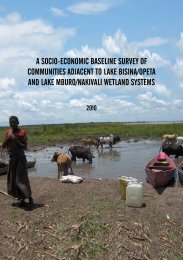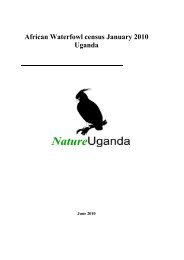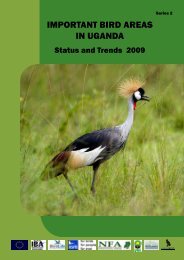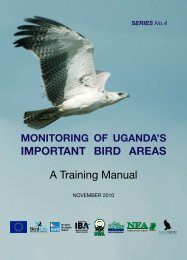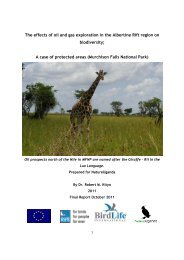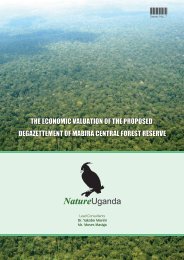A Ecological Baseline Surveys Of: - Lake Bisina - Nature Uganda
A Ecological Baseline Surveys Of: - Lake Bisina - Nature Uganda
A Ecological Baseline Surveys Of: - Lake Bisina - Nature Uganda
Create successful ePaper yourself
Turn your PDF publications into a flip-book with our unique Google optimized e-Paper software.
Flow modifications are very common in running waters and this is not an exception to the lakes<br />
in the wetland systems. Regulation of rivers that flow into the lakes could be one of the most<br />
significant anthropogenic impacts on the biodiversity of the lake e.g. River Ruizi that enters <strong>Lake</strong><br />
Mburo through Kachera, Kijanebalola into <strong>Lake</strong> Victoria. Changes in the hydrological regimes,<br />
reducing spring run-off, can lead to increased shoaling of river delta and reduction in the area of<br />
delta vegetation (reeds, cat-tail, and bushes). This loss of vegetation can result in a loss of aquatic<br />
fauna especially the migratory and semi-migratory fish species that are deprived of their natural<br />
spawning grounds. As spring flows are reduced, fish migration upriver for spawning is impeded and<br />
essential nursery areas are limited.<br />
Wide spread invasion and deliberate introduction of non-indigenous species adds to the physical and<br />
chemical impacts of humans to fish species diversity, in part because exotics usually successively<br />
invade native species already modified or degraded by humans e.g. the introduction of Nile perch<br />
and four tilapiine species in the basin provides a classic example. Escape of farmed fish into the<br />
wild is also associated with the floods that are common in these wetland systems.<br />
Climate change has started manifesting itself recently and its impacts can easily be depicted<br />
e.g. the current water fluctuation levels in water bodies. Climate change is associated with the<br />
continuous global increase in temperature and green house gas emissions. The global extent<br />
of climate change will mean that no ecosystem on earth will be immune from rising air or sea<br />
temperatures or changing weather patterns. The impact of climate changes on fish diversity in<br />
the basin is not yet well understood, but a general increase in ultraviolet radiation due to ozone<br />
depletion harms microscopic, photosynthetic algae and zooplankton at the base of the aquatic food<br />
web, potentially affecting the food supply of the entire water body community. Climate change may<br />
not only result in water level rise and severe storm damage but also temperature, salinity and other<br />
parameters causing a wide range of effects from species mortality, modifying species composition<br />
and migratory patterns to shifts in the entire aquatic system. However, the impact of climate change<br />
on biodiversity may be gradual compared to other threats.<br />
5.7 Discussion<br />
The first fishery survey of lakes Mburo and Kachira by Worthington (1929) up to early 1950s the<br />
most important commercial fish species in the lakes were Clarias spp, the lung fish Protopterus<br />
eathiopicus and haplochromines (Worthington, 1932). In lakes Opeta and <strong>Bisina</strong> like in the other<br />
Kyoga lakes the most important commercial species in order of importance were native tilapiines<br />
(O. esculentus and variabilis), the lung fish and catfishes Bagrus docmak, C. gariepinus, Schilbe<br />
intermedius, Barbus spp, Haplochromines and momyrids. The present surveys indicate that the fish<br />
communities of most of the assessed lakes in the wetland systems are composed of native species<br />
however in the Mburo-Nakivali systems new species were recorded namely O. esculentus and<br />
O. niloticus and these species were introduced in these lakes and dams in the early 1950s when<br />
the general introductions took place. Among the tilapiines cichlids, significant populations of the<br />
two native tilapiines remain in these lakes although they have been displaced from the main lakes<br />
Victoria, Kyoga, Nabugabo and Nakuwa where Nile perch has established (Ogutu-Ohwayo, 1990;<br />
Mbabazi et al., 2004; Chapman et al., 2008). The native tilapiines, which have disappeared from the<br />
main lakes, survive as both native and introduced populations in satellite lakes within the Victoria<br />
82<br />
<strong>Ecological</strong> <strong>Baseline</strong> <strong>Surveys</strong> of <strong>Lake</strong> <strong>Bisina</strong>, <strong>Lake</strong> Opeta, <strong>Lake</strong> Mburo and Nakivali Wetlands Systems



